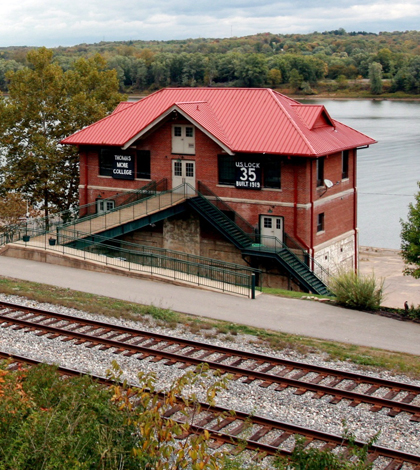Thomas More College Biology Field Station keeps sights on Ohio River

A small field station along the Ohio River has a big mission. In addition to educating students, the Thomas More College Biology Field Station provides research on the river’s toxicity and monitors the waterway in case of biowarfare events.
The former lock house, built in 1919, was operated by the U.S. Army Corps of Engineers into the 1960s. The wicket dam it overlooked was removed to make way for the larger towboats and barges just beginning to use the river in those days. When the college moved in near the late 60s, some renovations were needed to turn the field station into the hub for research and learning it is today.
“We use fathead minnows to look at the river’s toxicity,” said Meghann King, laboratory manager at the station. “Fatheads are kind of like the white mice of water studies.”
Students work with faculty at the station to keep a culture of fatheads growing for research purposes.
“The minnows are reproductive at six months old. We use breeder raceways and put tiles in to mimic rocks,” said King. “The new eggs hatch in four days.”
Young fish are transferred into a tank of river water within 24 hours after hatching. They take up water from the river, absorbing the chemicals and nutrients it contains.
“We’re interested in pharmaceutical drugs and other things entering the water that wastewater plants can’t remove,” King said. “So we want to see the effects on fish and effects on humans down the road.”
Regulating the fatheads’ reproductive cycle is an extensive process, requiring quality control checks along the way. The fathead culture system is checked once a month by the EPA, so the more reliable that data is, the better, King said.

The station’s aquaculture lab maintains fathead minnows for study.
The station recently secured new monitoring equipment to help keep pace with the needs of this and other projects, including sondes, a pyranometer and a weather station that plug into a NexSens data logger.
“The weather station will be used for teaching K-12 groups — it’s a teaching tool to show them what weather is like,” said King. “The data will also be available on our website so the community can use it.”
King says one sonde is for the fathead culture system while the other is for a river tank, which is part of another project with the EPA.
“The whole point of that is to keep an eye on the river in case of a biowarfare event,” said King. “We’re several miles upstream from Cincinnati, so there would be time to respond if we found anything.”
Asiatic clams grow in the tank that is connected to the Ohio River and each one is equipped with a sensor that monitors when it opens and closes its shell.
“Ordinarily, they’re open. If the clams shut, there’s something wrong,” said King. “I don’t think there’s anyone else really monitoring the Ohio River regularly like that.”
Data from the weather station and sondes is transmitted on a flat screen at the station’s entrance, letting visitors see first-hand the results of the station’s work.
“The goal is to put our data up and pique interest in learning about the environment, our weather station or tank systems,” said King. “A scientific person would definitely see that data and might want to get involved in research.”
Top image: Thomas More College Biology Field Station (Credit: Thomas More College)




0 comments